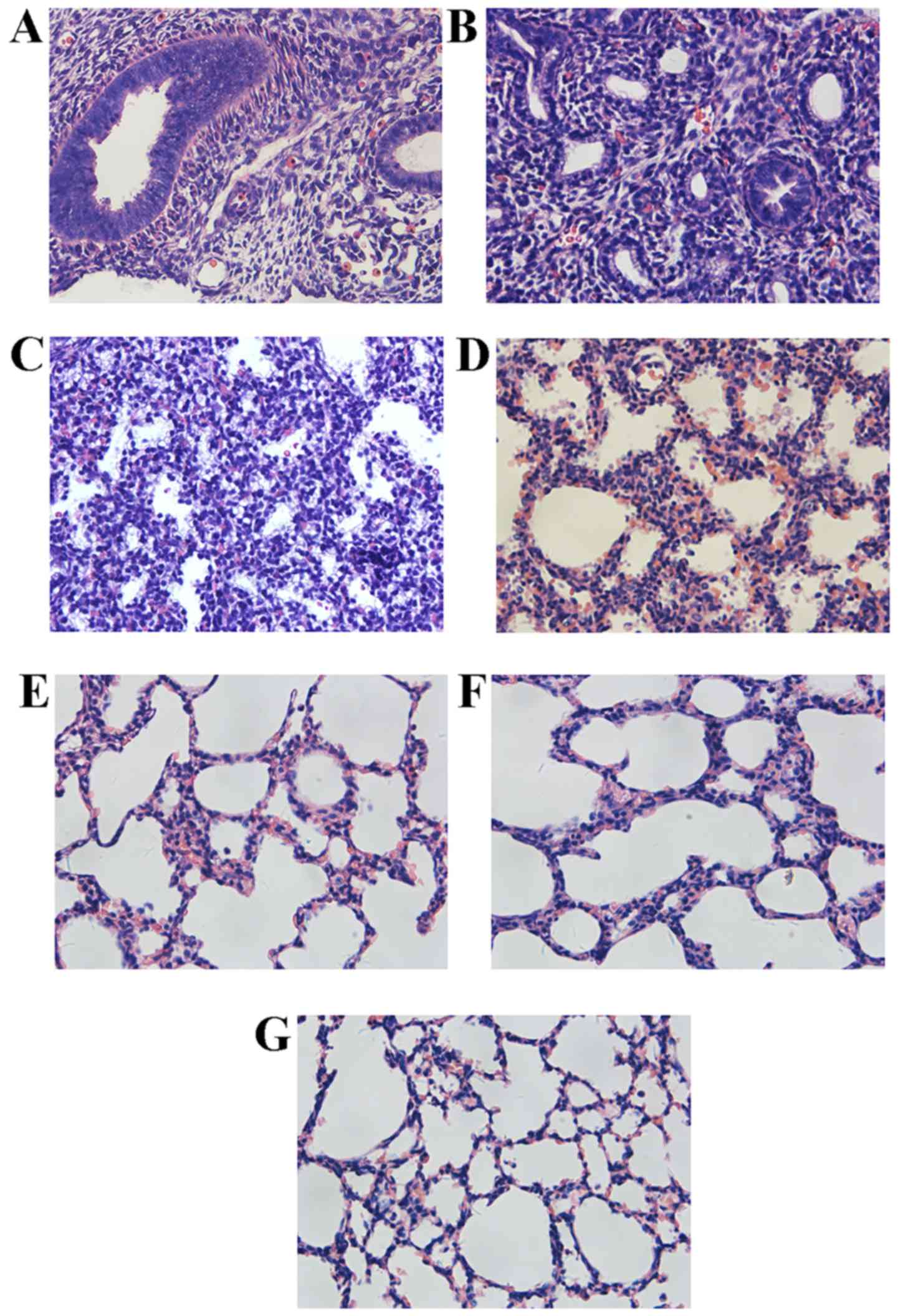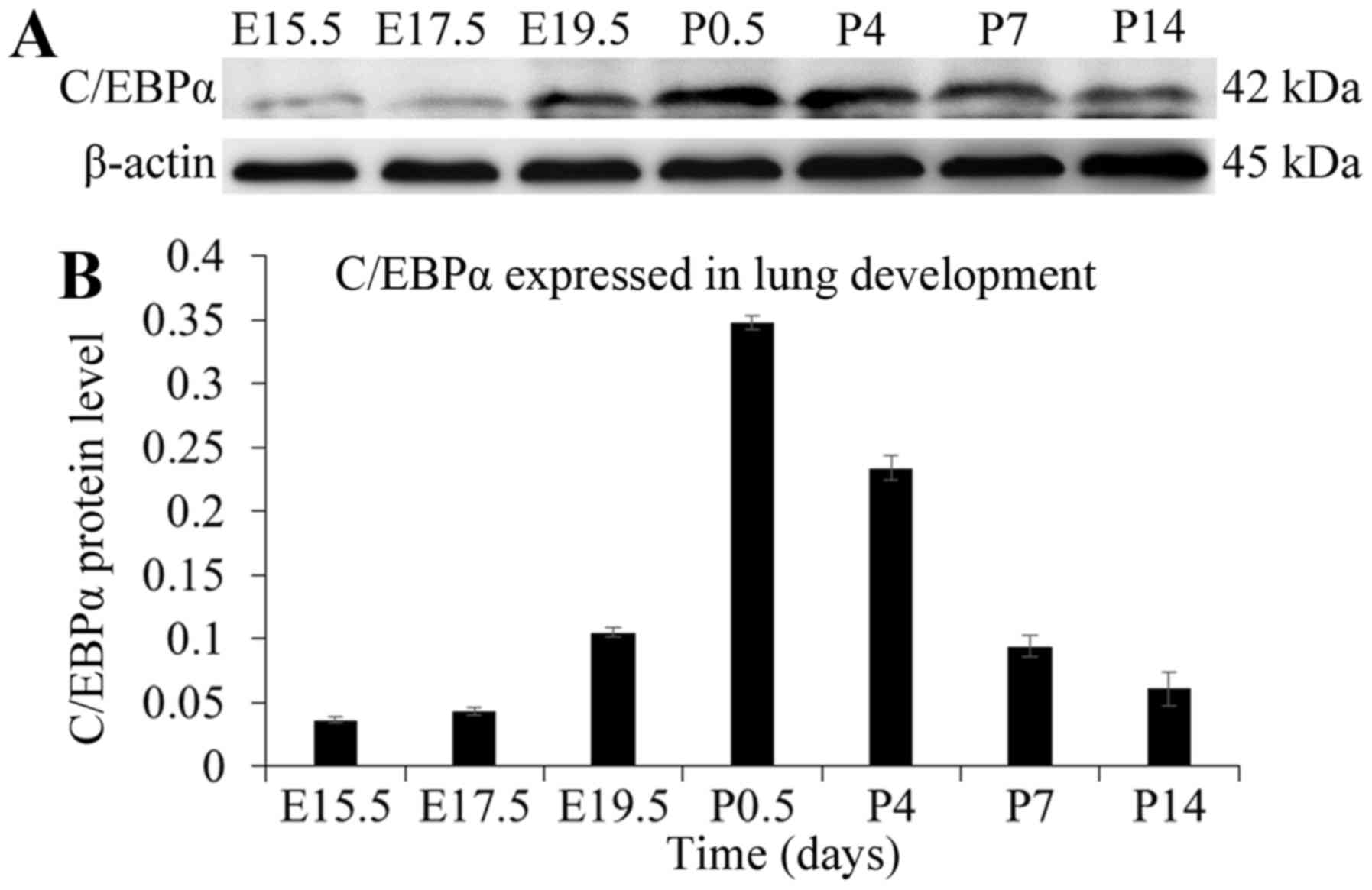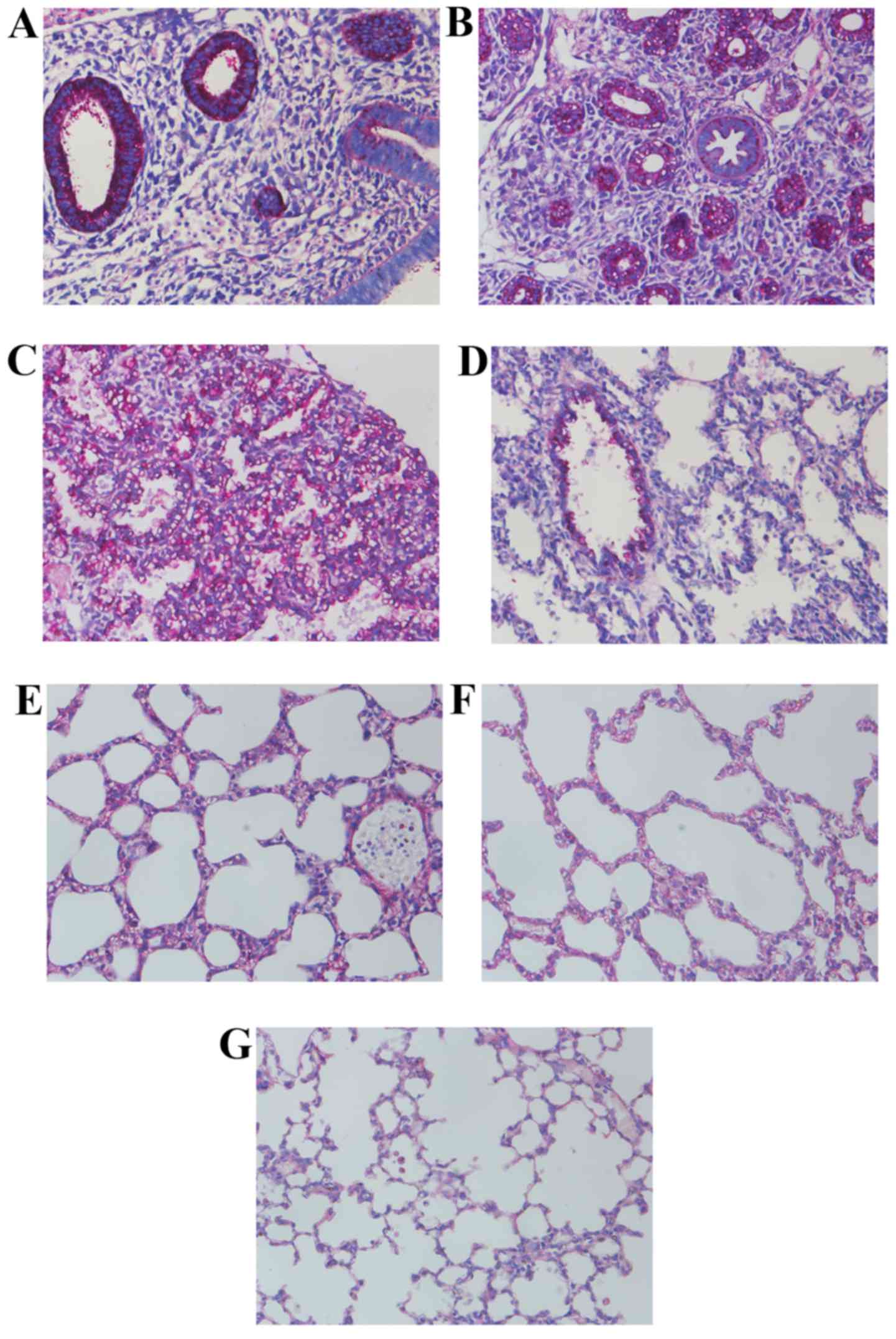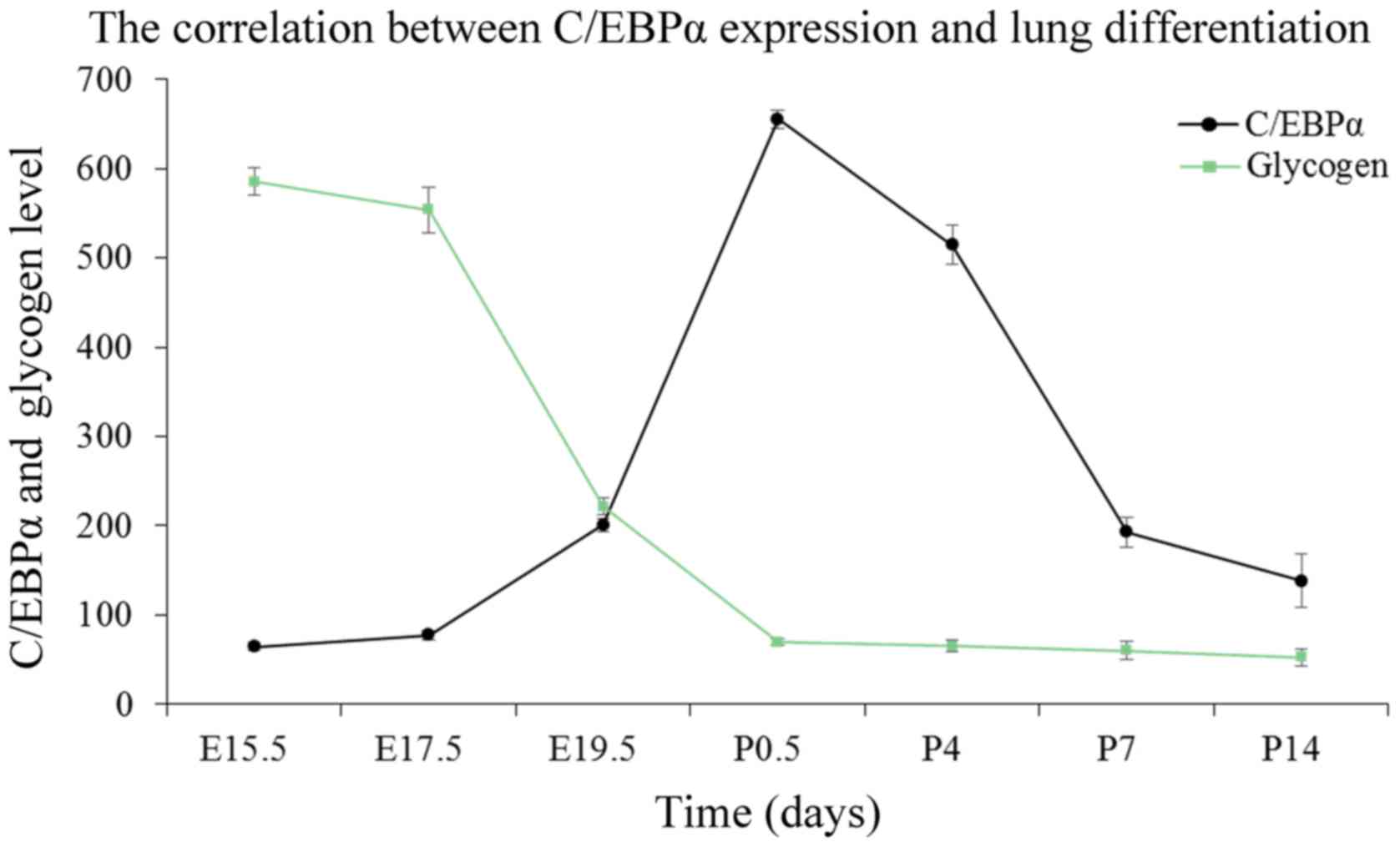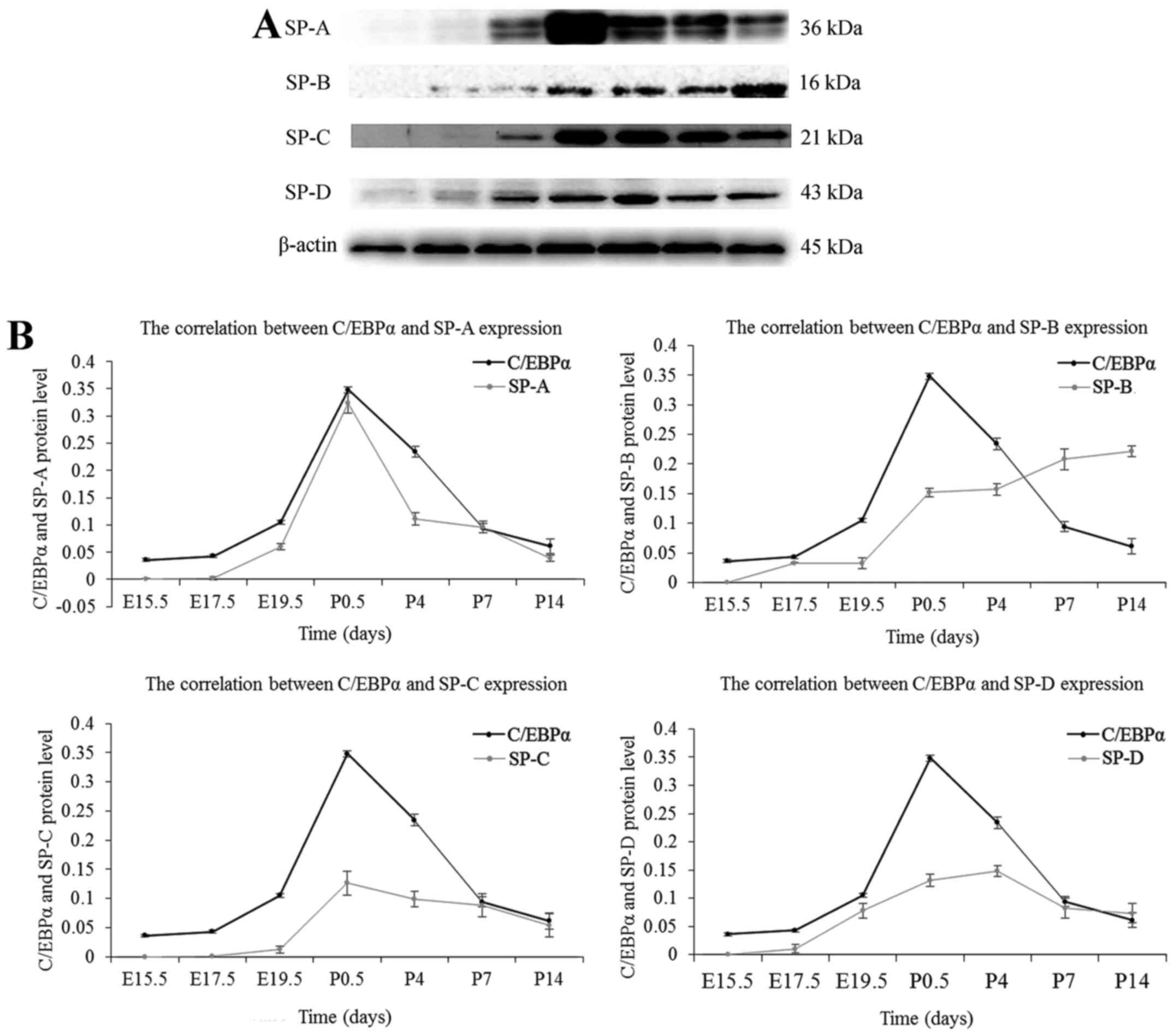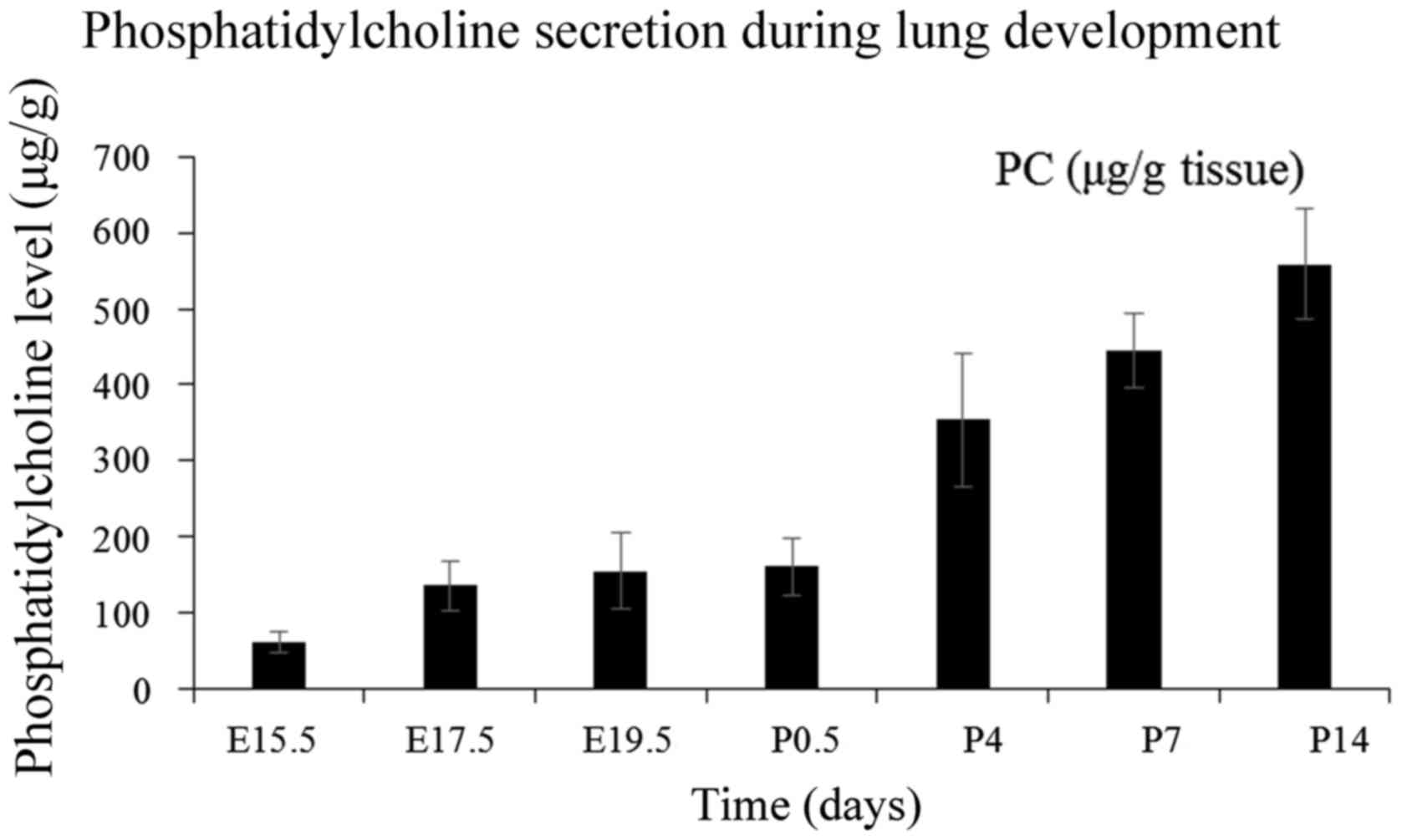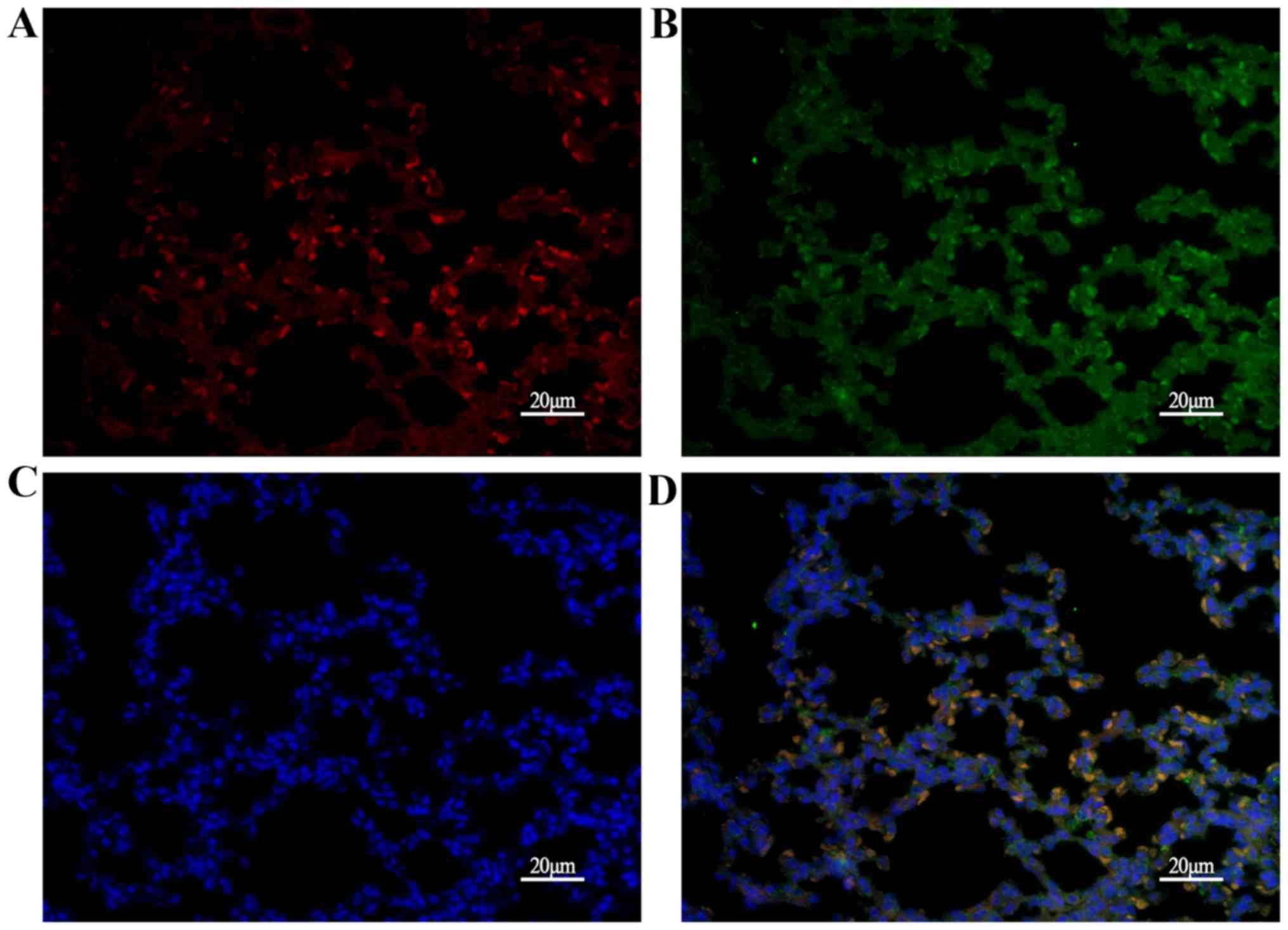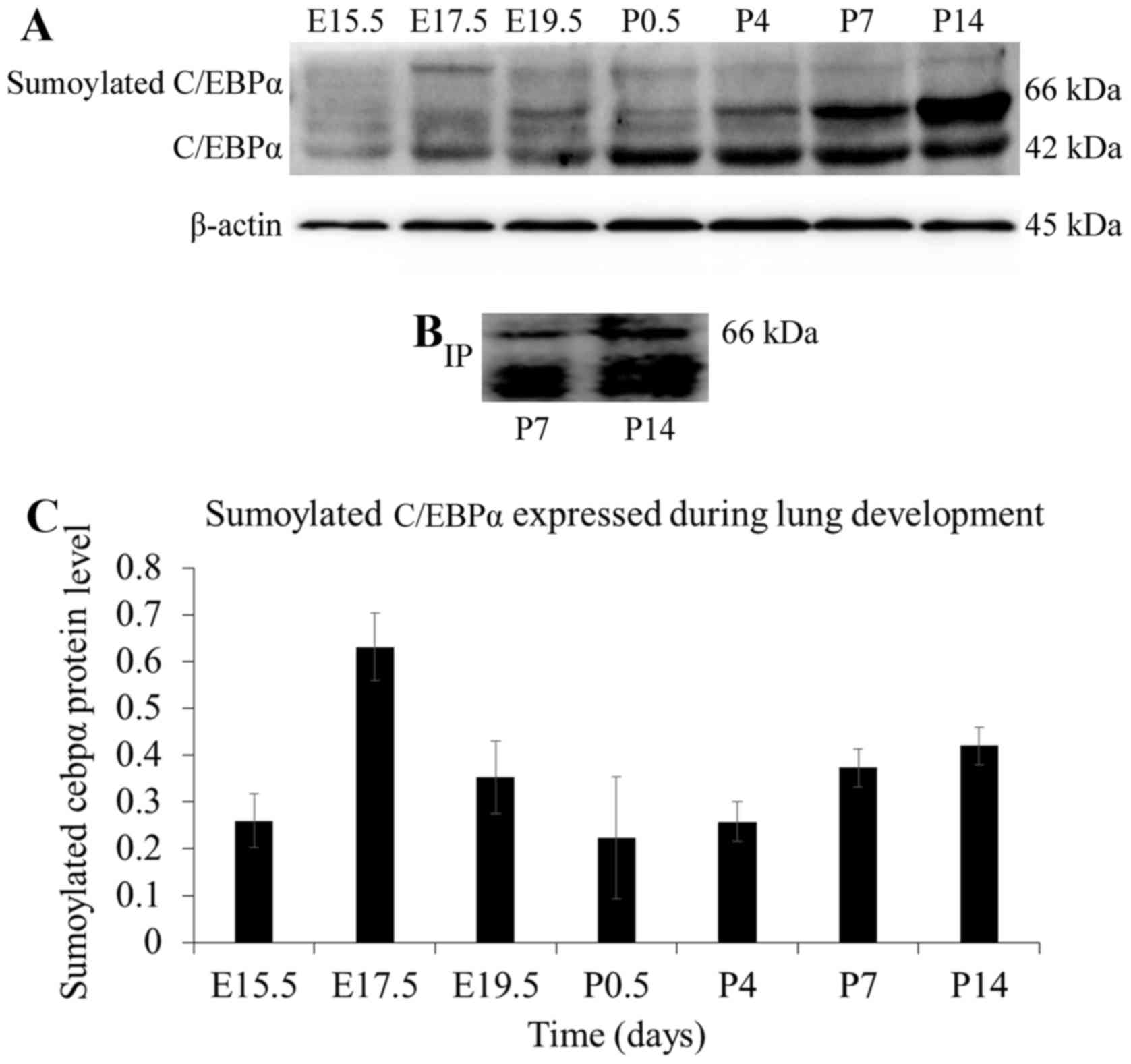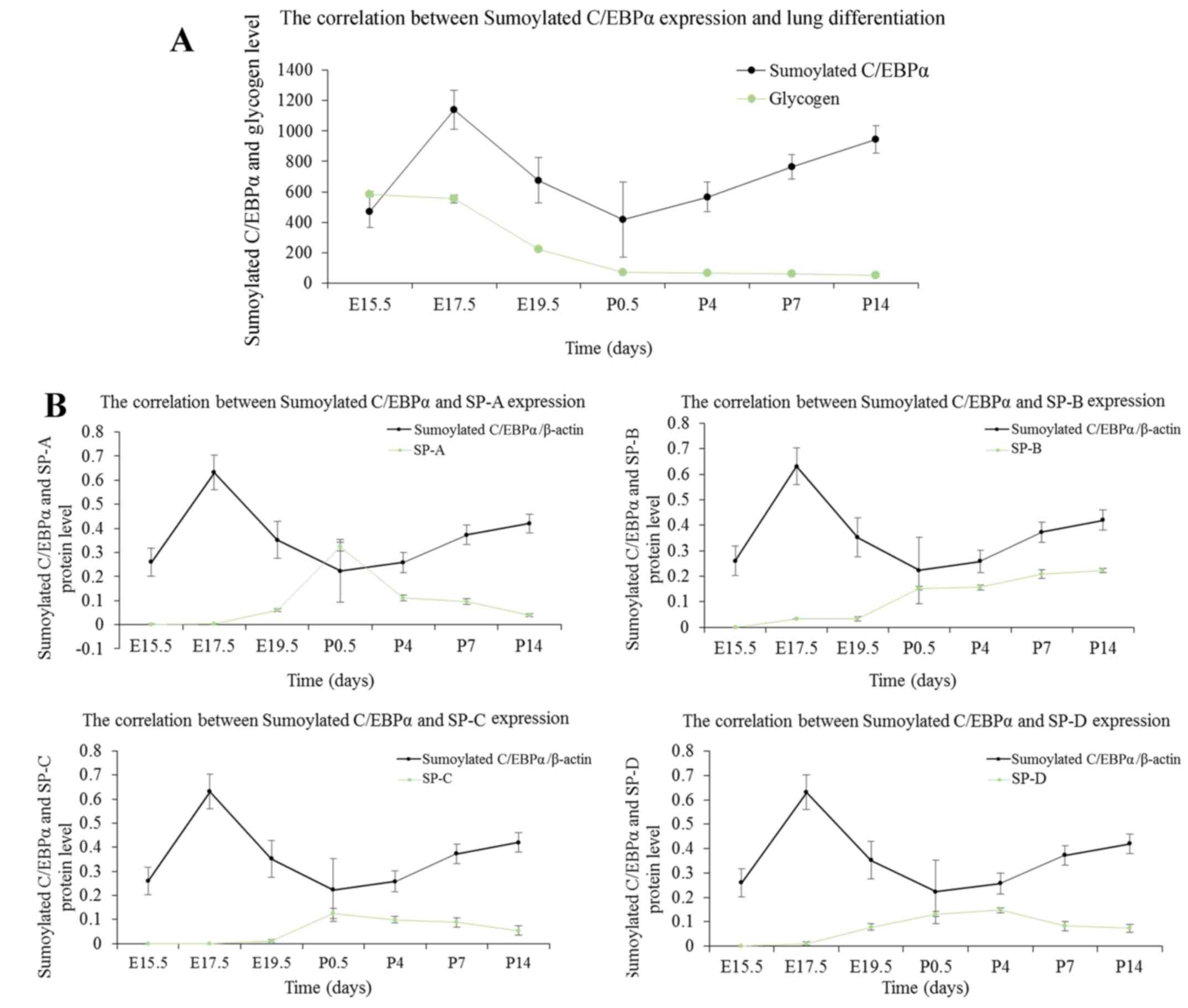Functional roles of C/EBPα and SUMO‑modification in lung development
- Authors:
- Published online on: August 29, 2017 https://doi.org/10.3892/ijmm.2017.3111
- Pages: 1037-1046
-
Copyright: © Chen et al. This is an open access article distributed under the terms of Creative Commons Attribution License.
Abstract
Introduction
According to the histomorphological characteristics, lung morphogenesis can be divided into five stages in the rat (1). First is the embryonic period, from fertilization to E9.5 (embryonic day 9.5). During this period of organogenesis, the lung primordium branches from the two lung buds that lie on each side of the future esophagus (2). The segmental branching of the airway is presented by 9.5 days of gestation, which results in the formation of tubular lung, and the following stage is referred to as the pseudoglandular period (E9.5–E16.5). At this stage, the primary lung buds grow ventrally and caudally, and five secondary buds are generated, which form the lobes of the mature lung. Recurrent sprouting and bifurcations of the lung buds result in the formation of pre-acinar airways arising from the process of branching morphogenesis. At the late pseudoglandular stage, the vascular development is quintessential, and all the numbers of pre-acinar airways are completely formed. Structurally, the lung development then enters the next phase, the canalicular period (E16.5–E17.5). Extensive cellular differentiation occurs in the late pseudoglandular and canalicular stages (3), the terminal branches of the bronchial tree are taking shape, and the cuboidal epithelium differentiates into type I and II cells, resulting in the formation of a thin air-blood barrier, as well as the secretion of surfactant. The cell differentiation continues, thereby forming the terminal sacs. These terminal sacs, as the name suggests, leads to the subsequent histological stage, which is known as the saccular period, spanning E17.5 to postnatal day 5 (P5), comprising the phase of rapid expansion (P1–P4). The major characteristics of this stage are increased growth of lung parenchyma, further maturation of the surfactant system, thinning of the interstitial tissue between the airspaces and the production of the last generation of airways by some future alveolar ducts and the outermost periphery alveolar sacs. Together, these changes prepare the lung for respiration after birth. The premature lung in the gestational age <35 weeks remains in the canalicular or saccular phase (4), which are sophisticated metamorphosis stages of lung development. The injury to the developing lung during this period alters subsequent alveolar and vascular development, resulting in simplified alveolar structures, dysmorphic capillary configuration, variable interstitial cellularity and fibroproliferation that are characteristic of the 'new' bronchopulmonary dysplasia (5). The alveolar period (P5–P30) is the last stage in lung development that is responsible for the accomplishment of alveolarization; it includes the phase of alveolarization (P5–P13) and the equilibrium stage (P14–P30).
CCAAT/enhancer binding protein alpha (C/EBPα) is the founding member of a family of basic region/leucine zipper transcription factors. A previous study indicated that C/EBPα participates in regulating the lung differentiation and pulmonary maturation (6). The expression of C/EBPα is initiated almost simultaneously to that of cellular differentiation and the emergence of differentiation markers (7). Furthermore, the studies in lung epithelial cell lines have demonstrated that the promoters of several differentiation-dependent genes harbor the C/EBP-binding sites (8–11); the C/EBPα-mediated regulation of these genes has also been proposed. Berg et al (12) reported that the abnormal expression of C/EBPα disrupts the lung development. These results indicated a role of C/EBPα in lung development; however, the molecular mechanism is poorly understood.
The post-translational modification is a vital regulatory mechanism underlying proteins exerting pleiotropic effects, thereby improving the structure and function of target proteins. Small ubiquitin-like modifier (SUMO) is a novel protein that can modify the target proteins causing rapid changes in the function and distribution of proteins, subcellular structures and multiprotein complexes (13). The pathway of sumoylation resembles that of ubiquitination, although the enzymes involved in the conjugation of SUMO are different. The SUMO peptide is first processed at the C-terminus by the ATP-dependent heterodimeric SUMO-activating E1 enzyme (Aos1/Uba2). Subsequently, it is transferred to the catalytic cysteine of the E2 conjugating enzyme, Ubc9 (14). The final step involves the transfer of the SUMO moiety from E2 to the specific substrate in the presence of an E3 ligase.
C/EBPα was previously reported to be post-translationally modified by SUMO at a lysine residue (K159) within the 'attenuator domain' of the protein that can negatively affect the transcriptional activity (15–17). Hankey et al (18) demonstrated that changes in the sumoylation status of C/EBPα might contribute towards a switch that regulates its transcriptional activity during normal neutrophil development. On the other hand, Sato et al (19) reported that the enhancement of C/EBPα-mediated transactivation by BRG1, which is a core subunit of the SWI/SNF chromatin remodeling complex, was inhibited by sumoylation. Furthermore, sumoylation dramatically decreased the expression of the liver-specific albumin gene that harbors the C/EBPα binding site. Notably, the common endodermal origin and the crucial role of C/EBPα in lung and liver suggest the potential transcriptional regulation and that SUMO may have a role in both organs. However, the role of SUMO-modification in the lung has not yet been reported. The C/EBPα studies are primarily focused on the mature lung. The mechanism through which C/EBPα regulates AEC-II (alveolar epithelial cells type II) differentiation and its effect on alveolar maturation in the premature lung have not yet beenclarified. The studies on C/EBPα and AEC II differentiation-related constituents, such as pulmonary surfactant proteins, phosphatidylcholine (PC) and glycogen are poorly reported.
In the present study, the authors investigated the level and functional role of C/EBPα during rat lung development. The correlation between the level of C/EBPα and the content of glycogen during lung maturation established a role of C/EBPα in lung differentiation. Furthermore, the changes in the status of C/EBPα were shown to be associated with the secretion of pulmonary surfactant. The SUMO modification of C/EBPα was also found to participate in this phenomenon. These findings indicated that C/EBPα serves a vital role in normal lung development, and provides further insights into the involvement of SUMO.
Materials and methods
Animals
Sprague-Dawley rats (90–100-days old, weight 250–300 g) were purchased from the Animal Center of Jiangsu University. All rats kept on a 12-h light/dark cycle at a room temperature of 23±2°C and a relative humidity of 50±5%, maintained on standard laboratory food and water ad libitum throughout the experiment. Rats were mated by 3:1 female: male ratio (15:5). The next morning, the female rats were checked for fertility and recorded as embryonic day 0.5 (E0.5). According to the different stages during the development of rat lung, the authors chose embryonic days 15.5, 17.5 and 19.5, and postnatal days 0.5, 4, 7 and 14 as the observation time-points. Embryos and lungs were isolated from the embryonic and postnatal stages as previously described, and a part of the samples was immediately fixed with 4% paraformaldehyde; the remaining part of the samples was stored at −80°C. The number of animals per group analyzed varies between 5 and 8. The protocols for animal studies were approved by the Laboratory Animal Ethics Committee of the Affiliated Hospital of Jiangsu University (Zhenjiang, China).
Histological analysis and periodic acid-Schiff (PAS) staining
Tissues were fixed with 4% paraformaldehyde in phosphate-buffered saline (PBS) for 24 h at 4°C, washed with PBS, dehydrated by an alcohol gradient and embedded in paraffin. Subsequently, 3 µm sections were sliced, followed by deparaffinization and rehydration through xylene, ethanol and water. The antigen retrieval was performed in 10 mM citrate buffer (pH 6.0) at a constant pressure of 20 cm H2O. The tissue sections were stained with either hematoxylin and eosin (H&E) for histological analysis, or PAS reagent (G1281) from Beijing Solarbio Science & Technology Co., Ltd., (Beijing, China) for analyzing the content of glycogen; the content of glycogen in alveolar epithelial cells reflect the maturity of AEC II (20). The sections were observed and images acquired by microscopy at magnification, ×400. PAS staining of the lung tissues revealed red- or purple-colored glycogen. The images were analyzed by Image-Pro Plus III (Media Cybernetics, Inc., Rockville, MD, USA) to obtain the mean gray value. A total of 3–5 samples/group were analyzed.
Antibodies
The primary antibodies used were anti-C/EBPα (sc-9314), anti-SP-B (sc-7704) and anti-SP-C (sc-13979 from Santa Cruz Biotechnology, Inc., Dallas, TX, USA), anti-SP-A (LS-C357574) from LifeSpan BioSciences, Inc. (Seattle, WA, USA), anti-SP-D (bs-1583R) from BIOSS (Beijing, China), and anti-SUMO-1 (4930) and anti-β-actin (#3700) from Cell Signaling Technology, Inc. (Danvers, MA, USA). Biotinylated secondary antibodies (FMS-MS01, FMS-Rb01, FMS-Gt01) were procured from Fcmacs Biotech Co., Ltd. (Nanjing, China). Donkey anti-rabbit IgG/fluorescein isothiocyanate (bs-0295D-FITC) and donkey anti-goat IgG/phycoerythrin (bs-0294D-PE) were obtained from BIOSS.
Western blot assay
Lung tissues were thawed on ice, washed with cold PBS, sliced into small pieces, lysed in radioimmunoprecipitation assay lysis buffer containing 1 mmol/l protease inhibitor PMSF (Sigma-Aldrich, Merck KGaA, Darmstadt, Germany) and homogenized by Dounce tissue grinders on ice. The extract was centrifuged at 12,000 × g and 4°C for 15 min; the supernatant was collected. Following normalization of protein concentrations between the samples by BCA kit (Beyotime Institute of Biotechnology, Shanghai, China), 10 ml of the lung lysates were resolved by 12% sodium dodecyl sulfate-polyacrylamide-gel electrophoresis (SDS-PAGE) and transferred to polyvinylidene difluoride membranes. The membranes were blocked in 5% milk-TBST containing 0.1% Tween-20 at 37°C for 2 h, and probed overnight with primary antibodies at 4°C. The following primary antibodies were used: anti-C/EBPα (1:200), anti-SP-A (1:500), anti-SP-B (1:200), anti-SP-C (1:500), anti-SP-D (1:200), anti-SUMO-1 (1:200) and anti-β-actin (1:1,000). The membranes were washed with TBST containing 0.1% Tween-20 and incubated with biotinylated secondary antibodies (1:5,000) for 1 h at 37°C. The immunoreactive bands were visualized by FluorChem FC3 chemiluminescence (ProteinSimple, San Jose, CA, USA) according to the manufacturer's recommendations. The protein expressions were quantified by densitometric analysis using LANE 1D software (Sage, Beijing, China).
PC assay
PC assay kit (ab83377, from Abcam, Cambridge, UK) was used to measure the levels of PC in various samples. Lung tissues were thawed on ice, washed with cold PBS, resuspended in the assay buffer provided by the kit, and homogenized with a Dounce homogenizer on ice. Then, the samples were centrifuged for 5 min at 4°C at 12,000 × g to exclude the insoluble material and collect the supernatant. An equivalent of 2.5 µg of the samples was loaded per well; PC reaction mixture was added, followed by development mixture according to the protocol of the kit. The colorimetric reaction was measured at 570 nm. The PC assay was carried out three times, following which, the concentration of PC was estimated.
Immunofluorescence
Double immunofluorescence staining was used to detect the localization of sumoylated C/EBPα. The sections were deparaffinized and rehydrated by xylene, ethanol and water. Antigen retrieval was performed in 10 mM citrate buffer (pH 6.0) at a constant pressure of 20 cm H2O. Subsequently, the sections were blocked with 5% serum in PBS for 20 min at room temperature, followed by incubation with the mixture of anti-C/EBPα (1:100) and anti-SUMO-1 (1:100) antibodies overnight at 4°C. Anti-C/EBPα was detected using a secondary PE-conjugated antibody (1:500) and anti-SUMO-1 was detected by a secondary FITC-conjugated antibody (1:500). The nucleus was counterstained with DAPI for 5 min at room temperature. All washes and antibody dilutions were made in PBS.
Immunoprecipitation
The immunoprecipitation protocol by Sato et al (19) was utilized for the detection of sumoylated C/EBPα. In order to detect the electrophoretic mobility of sumoylated C/EBPα, immunoprecipitation assay was carried out. A total of 20 mg lung tissues were thawed on ice, washed with cold PBS, sliced into small pieces and lysed with a buffer containing 1% Triton X-100, 150 mM NaCl, 20 mM Tris (pH 7.5) supplemented with protease inhibitors, followed by grinding using Dounce tissue grinders on ice. The extract was centrifuged at 12,000 × g and 4°C for 15 min; the supernatant was collected. The chromatin was preincubated with 2 µg anti-C/EBPα antibody for 30 min on ice. Then, 20 µl Protein A/G PLUS-Agarose beads (Santa Cruz Biotechnology) were added, and the mixture was incubated overnight at 4°C with gentle agitation. The antibody-coated beads were washed with lysis buffer and the immunoprecipitated proteins eluted by heat denaturation for 5 min in 5X Laemmli buffer containing 100 mM β-dithiothreitol. Immunoblotting, to detect the SUMO-1 protein, was performed as previously described.
Statistical analysis
The results are expressed as the mean ± standard error of the mean of at least three independent experiments. All data were analyzed by the SPSS statistical software (version 17.0; SPSS, Inc., Chicago, IL, USA). Pearson's correlation analysis was used to assess the relationship between indicators. P<0.05 was considered to indicate a statistically significant difference.
Results
Histomorphological variations of lung morphogenesis in different stages
As presented in Fig. 1, the ring-like pre-acinar airways could be observed at the late pseudoglandular stage at E15.5, lined by high columnar epithelium, surrounded by dense connective tissues. At E17.5, the primitive lung buds were separated completely. A large number of acinar luminae appeared, lined with simple cuboidal epithelium. In addition, the authors also observed the alveolar type I epithelial cells (AEC-I) at this stage. The primary alveolar was shaped at the early canalicular stage at E19.5, surrounded by thin connective tissues arranged in streak-like conformation. At P0.5, the number of primary alveoli was increased with irregularity in the structures. An increasing number of alveolar septa were formed at the late canalicular stage at P4 with some ridges protruding into the alveolar space. At P7, the size of air sacs was predisposed towards uniformity, and the interstitial tissues thinned out. By P14, the basic unit in the lung was mature alveoli, which appeared uniformly sized and separated by a razor-thin septum.
Dynamic expression pattern of C/EBPα protein during lung development
Rat lungs from different developmental stages were investigated for the expression pattern of C/EBPα using the western blot assay. As presented in Fig. 2, little expression of C/EBPα protein could be observed in lung tissues of the late pseudoglandular stage at E15.5. However, after the pseudoglandular-canalicular transition, the amount of C/EBPα protein increased gradually, and the trend was extremely obvious at E19.5 and P0.5. The C/EBPα protein reached its peak level at P0.5, following which, the expression weakened and finally stabilized at P14, resembling the expression pattern in the adult animal (12). In summary, C/EBPα displayed a trend of initial increase followed by a decrease during the lung development. C/EBPα was originally expressed in the late pseudoglandular phase characterized by growth and branching of the lung, which coincided with the cell differentiation and time of emergence of differentiation markers. After the pseudoglandular-canalicular transition, the expression increases and exhibits a widespread pattern, correlating with the extensive cellular differentiation occurring during this period (7).
Correlation between glycogen content and C/EBPα protein expression
The epithelial content of glycogen reflects the maturity of AEC-II (20). The intracellular glycogen is transformed into the pulmonary surfactant phospholipids; with AEC-II differentiation, the content is reduced gradually. As indicated by PAS staining of lung tissues in Fig. 3, the glycogen was identified by red or purple color. Glycogen occurs in the cytoplasm; the content was high at the late pseudoglandular stage at E15.5, followed by a decrease as the lung develops. This tendency is noticeable, especially at the canalicular and early saccular stages, which correspond to a wide range of cell differentiations during this stage. Finally, the glycogen content stabilized at the alveolar stage. To investigate the functional role of C/EBPα in AEC-II differentiation, the authors analyzed the link between the changes in the status of C/EBPα and the content of glycogen during lung maturation. As observed in Fig. 4, the level of glycogen exhibited a pattern approximately opposite to the expression of C/EBPα protein at the embryo and early postnatal stages, establishing a positive correlation between the C/EBPα expression and lung differentiation. At the late development period of the lung, primary and mature alveolar became the basic structural unit of lung tissue, and the pulmonary function improved gradually. The reduced glycogen consumption corresponds to the relatively low level of C/EBPα. This suggested that C/EBPα might facilitate cell differentiation throughout the lung development phase.
Correlation between pulmonary surfactant proteins and C/EBPα expression
Lung surfactant contains four associated proteins, surfactant protein (SP)-A, SP-B, SP-C and SP-D. In the present study, the authors investigated the secretion of pulmonary surfactant proteins during the whole development process of lung, using the western blot assay. As presented in Fig. 5, little expression of SP-A could be seen at the late pseudoglandular stage at E15.5, whereas SP-B, SP-C, and SP-D were first detected at E17.5; the expression of SPs was increased gradually with the development of fetal lung. The secretion of SP-A, SP-C and SP-D was maximal at the postnatal age between 12 h and 4 days, then decreased gradually and stabilized at P14. The expression of SP-B continued to rise after birth, and the increase was superior to the embryonic period. SP-B secretion increased slowly at P14 and stabilized gradually. The expression patterns of SPs were approximately similar to that of the C/EBPα protein except for SP-B. The results suggested a positive correlation between C/EBPα expression and the secretion of SPs; SPs are differentiation-dependent genes, and these results were consistent with the finding that C/EBPα promotes lung differentiation. However, the function of C/EBPα on SP-B during the postnatal days was not clarified.
Correlation between the secretion of pulmonary surfactant phospholipids and C/EBPα expression
The pulmonary surfactant phospholipids consist primarily of PC, synthesized in AEC-II, stored in the lamellar body, and excreted to the alveolar surface, thereby reducing the surface tension, increasing the compliance and preventing the alveolar collapse. The authors investigated the secretion of PC through lung tissues from various developmental stages. The augmented production of PC by fetal lungs does not commence until the gestation is ~80% complete (21). As presented in Fig. 6, the amount of PC at the late pseudoglandular stage is low. After a slow increasing period before birth, the content seems to increase rapidly at postnatal days and almost stabilizes during the alveolar period. The secretion pattern of PC was in accordance with the expression profile of C/EBPα in utero; however, the after-birth tendency was opposite without a significant correlation. Chen et al (22) reported that C/EBPα exerts a positive effect on adipocyte differentiation and restrains the accumulation of lipid. A slow increase of PC was observed at the embryonic period with a high expression of C/EBPα. Conversely, C/EBPα expression was reduced after birth, but the content of PC increased rapidly. Thus, it is possible that C/EBPα accelerates the secretion of AEC-II and metabolism of PC and other extracellular lipids concurrently. The secretion and cyclic utilization of PC are primarily regulated by SPs (23). As previously noted, C/EBPα exerts a positive effect on the expression of SP genes in the embryonic period, and thus, it may be speculated that C/EBPα can indirectly promote the synthesis of PC.
SUMO-modification of C/EBPα occurs during lung development
C/EBPα is considered to serve a vital role in lung morphogenesis and cytodifferentiation (12). The modification of C/EBPα by SUMO post-translationally can alter the protein function (24). However, explicit data on the sumoylated C/EBPα in lung development is absent, and therefore, rat lung tissues were used to study the sumoylation of C/EBPα. As presented in Fig. 7, SUMO-1 protein expressed during lung maturation. Next, C/EBPα and SUMO-1 were analyzed using immunofluorescence. As presented in Fig. 8, C/EBPα was partially colocalized with SUMO-1 in the AECs at P14, suggesting that sumoylation of C/EBPα occurred in the lung. Then, the expression of sumoylated C/EBPα during lung development was assessed. As shown in Fig. 9A, a shifted band attributable to modified C/EBPα was detected at different time-points during the development of rat lung. The shifted band seemed to be sumoylated C/EBPα, as its mobility was in accordance with that of the confirmed sumoylated C/EBPα in the hepatocytes (19). To confirm whether this shifted band was indeed SUMO-1-modified C/EBPα, the immunoprecipitation assay was carried out. As shown in Fig. 9B, the sumoylated C/EBPα was precipitated with the anti-C/EBPα antibody and immunoreacted with the anti-SUMO-1 antibody. The mobility of the SUMO-1-modified C/EBPα was found to be identical with that of the shifted band described above. Therefore, it was confirmed that this shifted C/EBPα band was generated by sumoylation.
Correlation between sumoylated C/EBPα and lung development
The above experiments suggested that the C/EBPα protein was sumoylated in the lung. C/EBPα is an established key regulator of lung development (25,26), and thus, the function of the sumoylated C/EBPα protein needs to be addressed. As shown in Fig. 9, sumoylated C/EBPα exhibits a developmental expression pattern during lung development, which was scarcely detected at the late pseudoglandular stage at E15.5; the expression increased and was maximal at E17.5, following which, the sumoylated C/EBPα decreased until the saccular period. At the alveolar stage, it increased slightly and finally stabilized. The decreased sumoylation of C/EBPα occurred at the lung development stage, which was characterized by extensive cell differentiation and secretion of pulmonary surfactant. The results demonstrated that the amount of glycogen exhibited a pattern approximately similar to the expression of sumoylated C/EBPα protein at the embryo and early postnatal stages. A negative correlation between sumoylation status of C/EBPα and lung differentiation was observed in Fig. 10A. In addition, as shown in Fig. 10B, the correlations of pulmonary surfactant secretion with C/EBPα and sumoylated C/EBPα were inverse. These data suggested that sumoylation may exert a suppressive effect on C/EBPα-mediated AEC-II differentiation and secretion.
Discussion
In the present study, the authors demonstrated that C/EBPα exhibits a dynamic expression pattern during lung development. To investigate the functional roles of C/EBPα in the lung, the authors analyzed its correlation to the differentiation and secretion of AEC-II, the accepted stem cell of the pulmonary epithelium (27). It was identified that the changes in the status of C/EBPα were associated with AEC-II differentiation as reflected by the content of glycogen during lung maturation. The expression pattern of C/EBPα protein is almost identical to that of SPs, and exerts a positive effect on AEC-II differentiation and secretion. In addition, SUMO was demonstrated to modify C/EBPα in the lung tissue, and sumoylation may have a negative effect on C/EBPα-mediated lung maturation.
During previous years, the physiological roles of C/EBPα have begun to be identified. C/EBPα is relatively highly expressed in the lung; is a key regulator of lung differentiation (25,26) and directly activates the transcription of several lung-specific and differentiation-dependent genes (10,11). C/EBPα expression is initiated in close temporal proximity to the emergence of AEC-II and the original formation of pulmonary surfactant system. The result has shown a positive correlation between the C/EBPα expression and AEC-II differentiation and secretion. The expression patterns of SPs, except SP-B, are almost similar to that of the C/EBPα protein. The promoter of SP-A and SP-D gene harbors the C/EBP binding sites (8,9). The current observations are in agreement with those described previously; C/EBPα was positively correlated with the expression trend of the two hydrophilic proteins, SP-A and SP-D. SP-B and SP-C are small hydrophobic proteins; their promoter contains the TTF-1 binding sites (28). TTF-1 is the synergy transcription factor of C/EBPα. C/EBPα, SP-A and SP-D occur primarily in AEC-II, and to a lesser extent in bronchioalveolar epithelial (Clara) cells (7,29,30). On the other hand, the expression of the SP-C gene is restricted to AEC-II (31), whereas that of SP-B occurs in both AEC-II and bronchiolar epithelial cells (29). As a result, a part of SP-B is not regulated by C/EBPα. In summary, C/EBPα exhibits a dynamic expression pattern during lung development; the expression of C/EBPα is related to the glycogen content and the secretion of SPs. Altogether, these results suggested that the role of C/EBPα in lung maturation is exercised by the regulation of pulmonary surfactant.
The authors demonstrated that C/EBPα could be modified by SUMO-1 protein in the lung; the sumoylated C/EBPα displays a negative correlation with AEC-II differentiation and secretion. This suggests that SUMO-modification may be involved in the regulation of C/EBPα-induced lung maturation. SUMO-1 modifies C/EBPα at lysine residue 159 within a conserved domain that negatively modulates the transcriptional activity (17). Sumoylation confers new protein-protein interaction properties of the transcription factors, which in turn can significantly alter the transcriptional activity. Histone deacetylases (HDACs) are typically correlated with the repression of transcription and can be recruited to sumoylated transcription factor complexes. C/EBPα promotes the transcription of several genes expressed in a tissue-specific and differentiation-dependent manner (32,33); HDAC3 interacts with sumoylated C/EBPα to negatively regulate the liver X receptor alpha expression (34). C/EBPα associates with the SWI/SNF complex and p21 can increase its stability and transcription activity; however, the sumoylation of C/EBPα inhibits the binding with these factors (19,35,36). Taken together, the presented results suggested that sumoylation might suppress the C/EBPα-mediated transactivation of SP genes and restrain PC synthesis indirectly. SPs are differentiation-dependent genes, and these results were consistent with the finding in our study that the sumoylation of C/EBPα expression is converse to lung differentiation. Therefore, additional studies on the effect of ectopic sumoylation of C/EBPα in lung are essential.
Furthermore, the results showed that the level of C/EBPα sumoylation was low in the developing lung, less than half of the total level of C/EBPα, similar to that reported for other sumoylated proteins (37–40). However, the physiological effects of sumoylation were abstruse. Intriguingly, the descending expression of sumoylated C/EBPα corresponded to the increasing C/EBPα at canalicular and saccular stages, the sophisticated metamorphosis period during the lung development. Injury during this phase will inhibit the expression of C/EBPα, resulting in abnormal lung differentiation and pulmonary surfactant secretion (41). In addition, a transient increase in the expression of SUMO-1 was observed at P4. The lung tissue was in a period of expansion during the postnatal days 1–3, which led to the improvement of pulmonary morphology and functions. At P4, the differentiation of AEC-II approached equilibrium, and the proliferation served as the major hallmark of expression. Sato et al (19) found that sumoylation of C/EBPα blocked its inhibitory effect on cell proliferation by disrupting the formation of a proliferation-inhibition complex owing to the failure of interaction between sumoylated C/EBPα and other proteins. This phenomenon has not yet been reported in the lung. However, the common endodermal origin and the crucial role of C/EBPα in the lung and liver suggested a common role of SUMO in both organs. This feature may provide a valuable insight into further investigations. The current results found that SUMO-modification participates in normal C/EBPα-mediated lung development, and offers a possibility that it might continue to partake in abnormal ways; thus, sumoylated C/EBPα may be a putative therapeutic target in lung injury.
Two isoforms were generated by the C/EBPα gene, with the resultant p42 kDa (full length) and p30 kDa (truncated) C/EBPα proteins, and the N-terminus is abbreviated in the p30 kDa protein. The heterodimerization between the two isoforms can restrain the ability of p42 C/EBPα to transactivate the target genes (24). The p30 C/EBPα can be sumoylated, although it is less sensitive to the changes in sumoylation than the p42 isoform (18). p30 C/EBPα enhances the sumoylation of p42 C/EBPα via the upregulation of Ubc9, which results in decreased transcriptional activity of the latter (15). Changes in the ratio of p42:p30 have been confirmed to contribute to tipping the scales from normal myelopoiesis to pre-leukemic or even leukemic myelopoiesis (42). As indicated in the results, there is a shifted band with electrophoretic mobility just lower to that of the sumoylated C/EBPα. We also observed a band at the consistent location by the immunoprecipitation assay. The shifted band could be speculated as the sumoylated p30 C/EBPα. Since similar investigations in the lung are absent, further studies are essential.
In conclusion, the authors found that C/EBPα exhibits a dynamic expression pattern during lung development and exhibits a positive effect on AEC-II differentiation and secretion. SUMO post-translationally modifies C/EBPα that occurs in the lung tissue; its expression during development corresponded to that during lung differentiation and several differentiation-dependent genes expression. Furthermore, these results suggested that sumoylation may act as a negative regulator of the C/EBPα-mediated transactivation in the lung.
Acknowledgments
The present study was supported by the National Natural Science Foundation of China (grant no. 81370746), the National Natural Science Foundation of Jiangsu Province (grant no. BK20161356) and the Social Development Foundation of Zhenjiang, China (grant no. SH2015071).
References
|
Cardoso WV: Lung morphogenesis revisited: Old facts, current ideas. Dev Dyn. 219:121–130. 2000. View Article : Google Scholar : PubMed/NCBI | |
|
Sakai T, Larsen M and Yamada KM: Fibronectin requirement in branching morphogenesis. Nature. 423:876–881. 2003. View Article : Google Scholar : PubMed/NCBI | |
|
Prodhan P and Kinane TB: Developmental paradigms in terminal lung development. BioEssays. 24:1052–1059. 2002. View Article : Google Scholar : PubMed/NCBI | |
|
Mullassery D and Smith NP: Lung development. Semin Pediatr Surg. 24:152–155. 2015. View Article : Google Scholar : PubMed/NCBI | |
|
Merritt TA, Deming DD and Boynton BR: The 'new' bronchopulmonary dysplasia: Challenges and commentary. Semin Fetal Neonatal Med. 14:345–357. 2009. View Article : Google Scholar : PubMed/NCBI | |
|
Mendelson CR: Role of transcription factors in fetal lung development and surfactant protein gene expression. Annu Rev Physiol. 62:875–915. 2000. View Article : Google Scholar : PubMed/NCBI | |
|
Cassel TN and Nord M: C/EBP transcription factors in the lung epithelium. Am J Physiol Lung Cell Mol Physiol. 285:L773–L781. 2003. View Article : Google Scholar : PubMed/NCBI | |
|
He Y and Crouch E: Surfactant protein D gene regulation. Interactions among the conserved CCAAT/enhancer-binding protein elements. J Biol Chem. 277:19530–19537. 2002. View Article : Google Scholar : PubMed/NCBI | |
|
Rosenberg E, Li F, Reisher SR, Wang M, Gonzales LW, Ewing JR, Malek S, Ballard PL, Notarfrancesco K, Shuman H, et al: Members of the C/EBP transcription factor family stimulate expression of the human and rat surfactant protein A (SP-A) genes. Biochim Biophys Acta. 1575:82–90. 2002. View Article : Google Scholar : PubMed/NCBI | |
|
Nord M, Låg M, Cassel TN, Randmark M, Becher R, Barnes HJ, Schwarze PE, Gustafsson JA and Lund J: Regulation of CCSP (PCB-BP/uteroglobin) expression in primary cultures of lung cells: Involvement of C/EBP. DNA Cell Biol. 17:481–492. 1998. View Article : Google Scholar : PubMed/NCBI | |
|
Cassel TN, Gustafsson JA and Nord M: CYP2B1 is regulated by C/EBP alpha and C/EBP delta inlung epithelial cells. Mol Cell Biol Res Commun. 3:42–47. 2000. View Article : Google Scholar : PubMed/NCBI | |
|
Berg T, Didon L and Nord M: Ectopic expression of C/EBPalpha in the lung epithelium disrupts late lung development. Am J Physiol Lung Cell Mol Physiol. 291:L683–L693. 2006. View Article : Google Scholar : PubMed/NCBI | |
|
Verger A, Perdomo J and Crossley M: Modification with SUMO. A role in transcriptional regulation. EMBO Rep. 4:137–142. 2003. View Article : Google Scholar : PubMed/NCBI | |
|
Tatham MH, Jaffray E, Vaughan OA, Desterro JM, Botting CH, Naismith JH and Hay RT: Polymeric chains of SUMO-2 and SUMO-3 are conjugated to protein substrates by SAE1/SAE2 and Ubc9. J Biol Chem. 276:35368–35374. 2001. View Article : Google Scholar : PubMed/NCBI | |
|
Geletu M, Balkhi MY, Peer Zada AA, Christopeit M, Pulikkan JA, Trivedi AK, Tenen DG and Behre G: Target proteins of C/EBPalphap30 in AML: C/EBPalphap30 enhances sumoylation of C/EBPalphap42 via up-regulation of Ubc9. Blood. 110:3301–3309. 2007. View Article : Google Scholar : PubMed/NCBI | |
|
Subramanian L, Benson MD and Iñiguez-Lluhí JA: A synergy control motif within the attenuator domain of CCAAT/enhancer-binding protein alpha inhibits transcriptional synergy through its PIASy-enhanced modification by SUMO-1 or SUMO-3. J Biol Chem. 278:9134–9141. 2003. View Article : Google Scholar : PubMed/NCBI | |
|
Kim J, Cantwell CA, Johnson PF, Pfarr CM and Williams SC: Transcriptional activity of CCAAT/enhancer-binding proteins is controlled by a conserved inhibitory domain that is a target for sumoylation. J Biol Chem. 277:38037–38044. 2002. View Article : Google Scholar : PubMed/NCBI | |
|
Hankey W, Silver M, Sun BS, Zibello T, Berliner N and Khanna-Gupta A: Differential effects of sumoylation on the activities of CCAAT enhancer binding protein alpha (C/EBPα) p42 versus p30 may contribute in part, to aberrant C/EBPα activity in acute leukemias. Hematol Rep. 3:e52011. View Article : Google Scholar | |
|
Sato Y, Miyake K, Kaneoka H and Iijima S: Sumoylation of CCAAT/enhancer-binding protein alpha and its functional roles in hepatocyte differentiation. J Biol Chem. 281:21629–21639. 2006. View Article : Google Scholar : PubMed/NCBI | |
|
Ridsdale R and Post M: Surfactant lipid synthesis and lamellar body formation in glycogen-laden type II cells. Am J Physiol Lung Cell Mol Physiol. 287:L743–L751. 2004. View Article : Google Scholar : PubMed/NCBI | |
|
Quirk JG, Bleasdale JE, MacDonald PC and Johnston JM: A role for cytidine monophosphate in the regulation of the glycerophospholipid composition of surfactant in developing lung. Biochem Biophys Res Commun. 95:985–992. 1980. View Article : Google Scholar : PubMed/NCBI | |
|
Chen SF, Sun J, Zheng L, Zhang ZL and Sun YS: Expressions of peroxisome proliferator-activated receptor gamma and CCAAT/enhancer binding protein alpha during the differentiation process of mouse 3T3-L1 preadipocytes. J Clin Rehabilitative Tissue Eng Res. 37:206–212. 2010. | |
|
Zhang XQ, Zhang P, Yang Y, Qiu J, Kan Q, Liang HL, Zhou XY and Zhou XG: Regulation of pulmonary surfactant synthesis in fetal rat type II alveolar epithelial cells by microRNA-26a. Pediatr Pulmonol. 49:863–872. 2014. View Article : Google Scholar : PubMed/NCBI | |
|
Khanna-Gupta A: Sumoylation and the function of CCAAT enhancer binding protein alpha (C/EBP alpha). Blood Cells Mol Dis. 41:77–81. 2008. View Article : Google Scholar : PubMed/NCBI | |
|
Didon L, Roos AB, Elmberger GP, Gonzalez FJ and Nord M: Lung-specific inactivation of CCAAT/enhancer binding protein alpha causes a pathological pattern characteristic of COPD. Eur Respir J. 35:186–197. 2010. View Article : Google Scholar | |
|
Miglino N, Roth M, Tamm M and Borger P: Asthma and COPD - The C/EBP connection. Open Respir Med J. 6:1–13. 2012. View Article : Google Scholar : PubMed/NCBI | |
|
Bishop AE: Pulmonary epithelial stem cells. Cell Prolif. 37:89–96. 2004. View Article : Google Scholar : PubMed/NCBI | |
|
Yang MC, Guo Y, Liu CC, Weissler JC and Yang YS: The TTF-1/TAP26 complex differentially modulates surfactant protein-B (SP-B) and -C (SP-C) promoters in lung cells. Biochem Biophys Res Commun. 344:484–490. 2006. View Article : Google Scholar : PubMed/NCBI | |
|
Wohlford-Lenane CL and Snyder JM: Localization of surfactant-associated proteins SP-A and SP-B mRNA in rabbit fetal lung tissue by in situ hybridization. Am J Respir Cell Mol Biol. 7:335–343. 1992. View Article : Google Scholar : PubMed/NCBI | |
|
Crouch EC: Structure, biologic properties, and expression of surfactant protein D (SP-D). Biochim Biophys Acta. 1408:278–289. 1998. View Article : Google Scholar : PubMed/NCBI | |
|
Wohlford-Lenane CL, Durham PL and Snyder JM: Localization of surfactant-associated protein C (SP-C) mRNA in fetal rabbit lung tissue by in situ hybridization. Am J Respir Cell Mol Biol. 6:225–234. 1992. View Article : Google Scholar : PubMed/NCBI | |
|
Birkenmeier EH, Gwynn B, Howard S, Jerry J, Gordon JI, Landschulz WH and McKnight SL: Tissue-specific expression, developmental regulation, and genetic mapping of the gene encoding CCAAT/enhancer binding protein. Genes Dev. 3:1146–1156. 1989. View Article : Google Scholar : PubMed/NCBI | |
|
Tsukada J, Yoshida Y, Kominato Y and Auron PE: The CCAAT/enhancer (C/EBP) family of basic-leucine zipper (bZIP) transcription factors is a multifaceted highly-regulated system for gene regulation. Cytokine. 54:6–19. 2011. View Article : Google Scholar : PubMed/NCBI | |
|
Ren J, Li D, Li Y, Lan X, Zheng J, Wang X, Ma J and Lu S: HDAC3 interacts with sumoylated C/EBPα to negatively regulate the LXRα expression in rat hepatocytes. Mol Cell Endocrinol. 374:35–45. 2013. View Article : Google Scholar : PubMed/NCBI | |
|
Harris TE, Albrecht JH, Nakanishi M and Darlington GJ: CCAAT/enhancer-binding protein-alpha cooperates with p21 to inhibit cyclin-dependent kinase-2 activity and induces growth arrest independent of DNA binding. J Biol Chem. 276:29200–29209. 2001. View Article : Google Scholar : PubMed/NCBI | |
|
Timchenko NA, Wilde M and Darlington GJ: C/EBPalpha regulates formation of S-phase-specific E2F-p107 complexes in livers of newborn mice. Mol Cell Biol. 19:2936–2945. 1999. View Article : Google Scholar : PubMed/NCBI | |
|
Le Drean Y, Mincheneau N, Le Goff P and Michel D: Potentiation of glucocorticoid receptor transcriptional activity by sumoylation. Endocrinology. 143:3482–3489. 2002. View Article : Google Scholar : PubMed/NCBI | |
|
Hirano Y, Murata S, Tanaka K, Shimizu M and Sato R: Sterol regulatory element-binding proteins are negatively regulated through SUMO-1 modification independent of the ubiquitin/26 S proteasome pathway. J Biol Chem. 278:16809–16819. 2003. View Article : Google Scholar : PubMed/NCBI | |
|
Degerny C, Monte D, Beaudoin C, Jaffray E, Portois L, Hay RT, de Launoit Y and Baert JL: SUMO modification of the Ets-related transcription factor ERM inhibits its transcriptional activity. J Biol Chem. 280:24330–24338. 2005. View Article : Google Scholar : PubMed/NCBI | |
|
Desterro JM, Keegan LP, Jaffray E, Hay RT, O'Connell MA and Carmo-Fonseca M: SUMO-1 modification alters ADAR1 editing activity. Mol Biol Cell. 16:5115–5126. 2005. View Article : Google Scholar : PubMed/NCBI | |
|
Bassères DS, Levantini E, Ji H, Monti S, Elf S, Dayaram T, Fenyus M, Kocher O, Golub T, Wong KK, et al: Respiratory failure due to differentiation arrest and expansion of alveolar cells following lung-specific loss of the transcription factor C/EBPalpha in mice. Mol Cell Biol. 26:1109–1123. 2006. View Article : Google Scholar : PubMed/NCBI | |
|
Pabst T, Mueller BU, Zhang P, Radomska HS, Narravula S, Schnittger S, Behre G, Hiddemann W and Tenen DG: Dominant-negative mutations of CEBPA, encoding CCAAT/enhancer binding protein-alpha (C/EBPalpha), in acute myeloid leukemia. Nat Genet. 27:263–270. 2001. View Article : Google Scholar : PubMed/NCBI |



